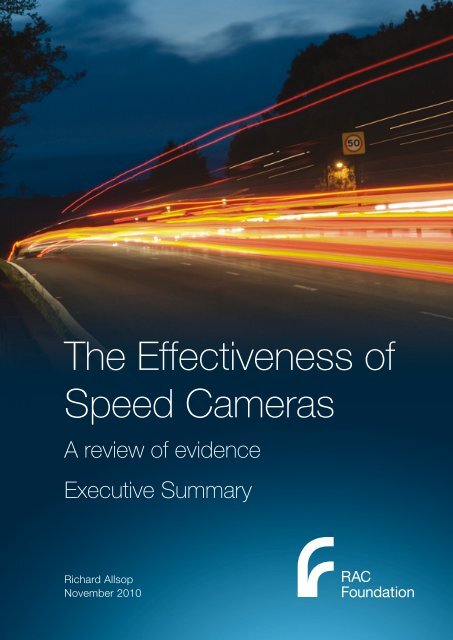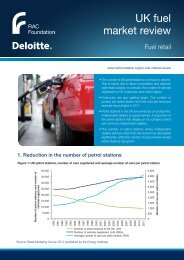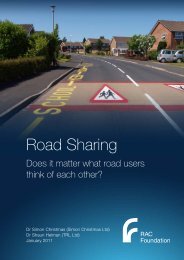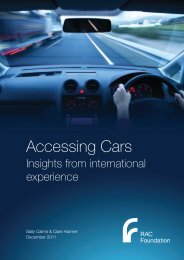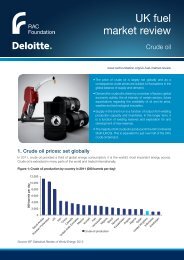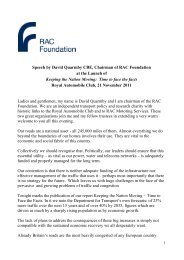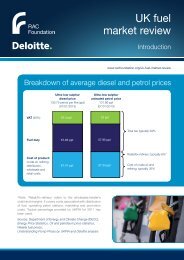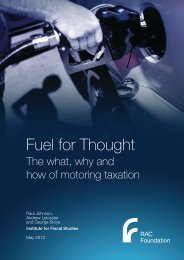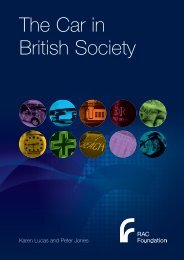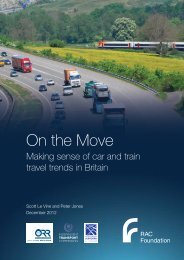Speed camera effectiveness - Allsop - exec ... - RAC Foundation
Speed camera effectiveness - Allsop - exec ... - RAC Foundation
Speed camera effectiveness - Allsop - exec ... - RAC Foundation
- No tags were found...
You also want an ePaper? Increase the reach of your titles
YUMPU automatically turns print PDFs into web optimized ePapers that Google loves.
The Effectiveness of<strong>Speed</strong> CamerasA review of evidenceExecutive SummaryRichard <strong>Allsop</strong>November 2010
The Royal Automobile Club <strong>Foundation</strong> for Motoring Limited is a charity which explores the economic,mobility, safety and environmental issues relating to roads and responsible road users. Independent andauthoritative research, carried out for the public benefit, is central to the <strong>Foundation</strong>’s activities.<strong>RAC</strong> <strong>Foundation</strong>89-91 Pall MallLondonSW1Y 5HSTel no: 020 7747 3445www.racfoundation.orgRegistered Charity No. 1002705November 2010 © Copyright Royal Automobile Club <strong>Foundation</strong> for Motoring Limited
AcknowledgementsThe author is grateful to road safety partnerships, and the Association of ChiefPolice Officers (ACPO) and its Road Safety Support team for providing recentdata, and allowing it to be used in this report. The author is also grateful to peerreviewers and colleagues for their helpful comments on drafts of the report.The <strong>RAC</strong> <strong>Foundation</strong> would like to acknowledge advice received from Ingridvan Schagen, Senior Researcher, SWOV Institute for Road Safety Research,The Netherlands, and Janet Kennedy, Senior Research Fellow, TransportResearch Laboratory, UK. It is stressed that the opinions and conclusionsoutlined in this paper are solely those of the author.About the authorProfessor Richard <strong>Allsop</strong> has extensive experience of research, trainingand advisory work on road safety, traffic management and other aspects oftransport policy. He has a first in Mathematics from Cambridge, and a PhD andDSc from UCL (University College London), where he is Emeritus Professor ofTransport Studies, having been Professor since 1976 and Director betweenthen and 1997 of what is now the Centre for Transport Studies.He has a longstanding involvement in road safety research and policy,including being a Director of PACTS (the Parliamentary Advisory Council forTransport Safety). He is a Board Member of the European Transport SafetyCouncil (ETSC) and leads its European road safety performance indexprogramme PIN. He has also provided inputs to road safety policy in Australia,Hong Kong, Japan, New Zealand and Poland.He was made an OBE in 1997 for services to traffic management and roadsafety, is a Fellow of the Royal Academy of Engineering and holds the IHTAward for professional excellence.Please visit the <strong>RAC</strong> <strong>Foundation</strong> website at www.racfoundation.organd click on ‘Research’ to download a full copy of the report.
ForewordIf there is one subject which divides drivers like noother it is speed <strong>camera</strong>s. Are they a mechanismfor saving life or a method of raising revenue? Havethey, as some contend, actually increased thecasualties on our roads?What follows in the body of this report is a thorough,independent, statistical evaluation of the facts aswe have them.It is not a simple read, because this is not a simplesubject to analyse, yet the conclusions of ProfessorRichard <strong>Allsop</strong> of University College London arestrikingly clear: fixed and mobile speed <strong>camera</strong>ssave lives; and a lot of them.The current crisis in funding for speed <strong>camera</strong>s – and road safety in general– leaves road users at real risk. Put more starkly; the overwhelming evidenceis that if speed <strong>camera</strong>s were to be decommissioned across Great Britainthen about 800 more people per year could be killed or seriously injured. Thiscountry should be proud of the progress it has made in reducing deaths onthe roads over recent years. However there is a real risk of this trend beingreversed if we do not find the funds to continue operating <strong>camera</strong>s or someequally effective alternative.Professor <strong>Allsop</strong> has no axe to grind and no vested interest in the successof speed <strong>camera</strong>s. He is a respected academic with many years of analyticalexperience in this field; hence the reason the <strong>RAC</strong> <strong>Foundation</strong> approached himto undertake this study.Professor <strong>Allsop</strong> has looked at data from a range of speed <strong>camera</strong> efficacystudies. He has also examined previously unpublished information from anumber of road safety partnerships. The findings are unambiguous. Camerashave historically saved lives. They continue to save lives. And should they beremoved, speeds will rise and so will accidents.Professor <strong>Allsop</strong>’s work also demonstrates that <strong>camera</strong>s are not significantrevenue raisers for the general Exchequer. In 2006-7 for example, from each£60 penalty notice, there was a mere £4 surplus after the cost of <strong>camera</strong>operations was met.Other researchers looking at the efficacy of speed <strong>camera</strong>s have reachedsimilar conclusions. In October 2010 the Cochrane Review of 35 studies into
their <strong>effectiveness</strong> worldwide said that while different methodologies meant anorder of magnitude was impossible to deduce:‘… the consistency of reported reductions in speed and crashoutcomes across all studies show that speed <strong>camera</strong>s are aworthwhile intervention for reducing the number of road trafficinjuries and deaths.’While this report fully lays out the background to the introduction of speed<strong>camera</strong>s and the need for speed limits, its job is not to justify why the nationallimits are what they are; a review of speed limits to see whether they aresoundly based is for another day. What it has done is show that at <strong>camera</strong>ssites, speeds have been reduced, and as a result, collisions resulting in injurieshave fallen.The government has said a decision on whether speed <strong>camera</strong>s should befunded must be taken at a local level. With the pressure on public funds therewill be – indeed they already are – those who say that what little money thereis can be better spent. This report begs to differ. The devices are already there;they demonstrate value for money, yet are not significant revenue raisers forTreasury; they are shown to save lives; and despite the headlines, most peopleaccept the need for them.<strong>Speed</strong> <strong>camera</strong>s should never be the only weapon in the road safety armoury,but nor should they be absent from the battle.Professor Stephen GlaisterDirector<strong>RAC</strong> <strong>Foundation</strong>
Executive SummaryBackground<strong>Speed</strong> <strong>camera</strong>s were first used for enforcement in Great Britain in 1992as recommended by a review of road traffic law in 1988. Their rollout wasaccelerated between 2001 and 2005 in a national safety <strong>camera</strong> programmeunder the ‘safer speeds’ theme of the road safety strategy 2000-2010.<strong>Speed</strong> <strong>camera</strong> partnerships – joint ventures between police forces, highwayauthorities and magistrates’ courts – were formed to do this and have sincetaken on a wider role as road safety partnerships.Sources of informationThis report pulls together a range of analyses on the <strong>effectiveness</strong> ofspeed <strong>camera</strong>s, and some more recent data, to provide a considered andcomprehensive assessment of their contribution to road safety. The sourcesof information include the four-year <strong>camera</strong> evaluation report publishedin December 2005; related work by Mountain, Hirst and Maher; studies inLondon; national statistics on traffic speeds, collisions and casualties andinternational research on relations between them; and recent figures from roadsafety partnerships.Changes in speedThe four-year evaluation report mentioned above looked at 2000 sites (urbanand rural, using fixed and mobile <strong>camera</strong>s) where speed measurements weretaken both before and after <strong>camera</strong> deployment. Analysis showed that oncethe <strong>camera</strong>s were operational there was:• a substantial improvement in compliance with speed limits;• a particular reduction in extreme speeding;• a marked reduction in average speed at fixed sites; and• an appreciable, though more modest, reduction at mobile sitesCasualty reduction at speed <strong>camera</strong> sitesBut these changes in speed are not an end in themselves. The laws of motionimply that lower speeds just before and at the instant of collisions are associatedwith more time for drivers to take avoiding or mitigating action, lesser exchangeof energy and momentum during the collisions, and consequently lower forcesimposed on the bodies of people involved and lower severities of injury.
It is clear that collisions and casualties decreased substantially at the morethan 4000 sites covered by the four-year evaluation. However, not all of thedecrease can be attributed to the speed <strong>camera</strong>s.Some decrease would have been expected because of the downward nationaltrend in casualty numbers. Another part of the reduction is likely to haveresulted from the phenomenon of Regression to the Mean (RTM). This isbecause many <strong>camera</strong>s were installed at sites which had just previously haduntypically high numbers of casualties, and this would have happened partlyby chance and only partly because of inherently dangerous conditions at thosesites. The numbers of casualties would therefore have been expected to fallanyway due to the effect of RTM. Allowance for RTM is important but hard toestimate.Some of the reduction might also have been attributable to drivers divertingto avoid <strong>camera</strong>s, but the overall reduction might well have been greater hadit not been for some collisions being caused by drivers suddenly braking andthen accelerating in the vicinity of <strong>camera</strong>s.But after working in all these factors, the judgement can be made that in theyear ending March 2004, <strong>camera</strong> operations at more than 4,000 sites acrossGreat Britain prevented some 3,600 personal injury collisions (PIC), savingaround 1,000 people from being killed or seriously injured (KSI):Type of siteNumber prevented in year ending March 2004PICKSIFixed urbanFixed ruralMobile urbanMobile ruralBetween 1700 and 2200Between 170 and 300Between 1000 and 1400Between 180 and 300Between 500 and 560Between 60 and 140Between 150 and 400Between 90 and 200All sites Between 3050 and 4200 Between 800 and 1300These figures are broadly consistent with what one might expect to see atsites like these in light of the internationally accepted Power Model of therelationships between changes in numbers of collisions and casualties on astretch of road and changes in the average speed of traffic.Wider changes in speed and numbers of casualties on all roadsNational speed surveys show that in free-flowing traffic on all roads with a30 mph limit, the average speed of cars fell from 33 to 30 mph between 1997and 2005. The proportion exceeding the limit also fell. While there have beenother moderating influences on speed such as traffic calming and publicinformation campaigns, the period of steepest decline (between 2001 and
2005) in the proportion of drivers exceeding the 30 mph limit coincided withthe rollout of <strong>camera</strong> enforcement:mph40Average speed of carsPercentage exceeding 30 mphper cent80306020401020001995 2000 2005 2010Trends in average speed of cars and percentage exceeding the speedlimit in free-flowing traffic on roads with a 30 mph limitThere is no evidence of counterpart reductions in speed between 1997 and2005 on roads with speed limits higher than 30 mph. However, numbers ofcasualties fell similarly on both urban and rural roads. A major contributor tocasualty reduction in both cases has been improved car occupant protection.Whilst car drivers and passengers made up two-thirds of casualties on ruralroads they made up only one-third on urban roads. So a bigger reductionmight have been expected on rural than on urban roads because of improvedoccupant protection. The decrease in speeds and speeding on 30 mph roadsmay well have helped the fall in casualties on urban roads to match that onrural roads.The key findings of this report• Deployment of speed <strong>camera</strong>s leads to appreciable reductions in speedin the vicinity of the <strong>camera</strong>s and substantial reductions in collisions andcasualties there over and above the likely effects of regression to the mean.• Reductions in collisions and casualties differ between fixed and mobile,and between urban and rural <strong>camera</strong> sites. Judging from the evidence,the operation of <strong>camera</strong>s at over 4,000 sites of all types resulted in around1,000 fewer people being killed or seriously injured in the vicinity of<strong>camera</strong>s in the year ending March 2004.• National surveys indicate clear and sustained falls in the average speedsof cars on 30 mph roads, and in the proportion of cars exceeding the limit,which are likely to have contributed to concurrent reductions in collisionsand casualties on built-up roads.
• The evidence from a study in West London is that speed <strong>camera</strong>s led to areduction in casualties not only at <strong>camera</strong> sites, but across the wider roadnetwork.• Majority public acceptance of <strong>camera</strong>s was widespread at the heightof the national <strong>camera</strong> safety programme. Subsequent annual surveysby the AA indicate that it has remained so, with three-quarters of thosequestioned in October 2010 regarding the use of <strong>camera</strong>s as acceptable.• Increases in speeds and speeding at various sites where <strong>camera</strong>s werevisibly out of action have been recorded over the years since 2004.• Data for 2007-2009 supplied by a number of road safety partnerships,while not covering the whole country, suggests that big falls in fatal orserious casualties at <strong>camera</strong> sites have persisted over time.• National decommissioning could result in about 800 extra people acrossGreat Britain being killed or seriously injured each year.• In the year ending March 2004 the benefit/cost ratio of <strong>camera</strong>enforcement was about 2.3. Data for 2006-07 shows the cost of <strong>camera</strong>enforcement was being covered by penalties paid by detected offenderswith only a modest surplus to the Exchequer of less than £4 out of each£60 penalty paid.This review is confined to the British experience of speed <strong>camera</strong> enforcement,but a recently updated Cochrane Review of 35 speed <strong>camera</strong> studiesworldwide concluded:‘…the consistency of reported reductions in speed and crashoutcomes across all studies show that speed <strong>camera</strong>s are aworthwhile intervention for reducing the number of road trafficinjuries and deaths.’The findings of this review for the <strong>RAC</strong> <strong>Foundation</strong>, though reachedindependently, are essentially consistent with the Cochrane Reviewconclusions. They are also broadly consistent with the findings of a metaanalysisreported in the respected Handbook of Road Safety Measures, of 16studies, not including the four-year evaluation report, of the effects of fixed<strong>camera</strong>s on numbers of collisions and casualties.
The Royal Automobile Club <strong>Foundation</strong> for Motoring Limited is a charity whichexplores the economic, mobility, safety and environmental issues relating to roadsand responsible road users. Independent and authoritative research, carried outfor the public benefit, is central to the <strong>Foundation</strong>’s activities.<strong>RAC</strong> <strong>Foundation</strong>89-91 Pall MallLondonSW1Y 5HSTel no: 020 7747 3445www.racfoundation.orgRegistered Charity No. 1002705November 2010 © Copyright Royal Automobile Club <strong>Foundation</strong> for Motoring LimitedDesigned and printed byThe Javelin Partnership LtdTel: 01189 303 123Produced on paper from a managedsustainable source, using pulp that is ECF,also FSC certified as containing 50% recycled waste.


